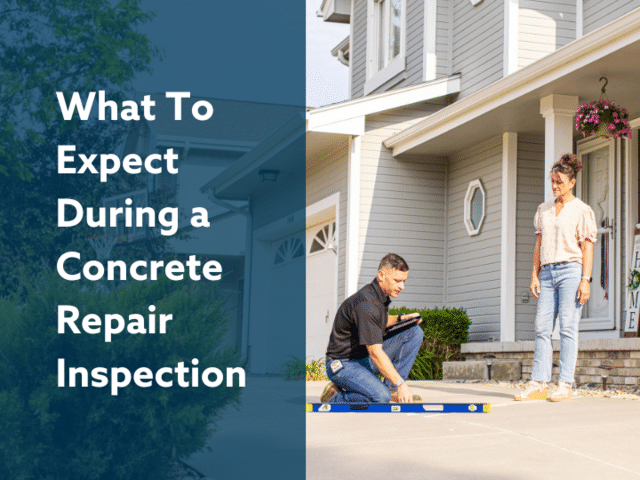Mudjacking vs. Polyjacking: What's The Best Concrete Repair Method?

If your driveway, patio, pool deck, or any of your other home’s concrete surfaces are sinking, then you’re faced with the crucial decision of choosing the right concrete repair method. This is where the debate between mudjacking and polyjacking comes into play.
In this blog, we'll compare both mudjacking and polyjacking so you can make the most informed decision for your home. It's a decision that deserves careful consideration, and that's precisely what we're here to help you with.
Full disclosure: We feel it’s important to mention that we’ve dabbled with mudjacking and polyjacking, but now exclusively offer polyjacking for concrete repair. We’ll discuss the reasons for this switch with full transparency, but we promise to give you an unbiased and informative comparison of both. Above all else, we want to give you the information you need to make the right decision for your home.
So, let's dive in and explore the world of concrete repair, weighing each method's pros and cons to determine which one is truly worth it.
First: Why does concrete sink and crack?
Before we talk about concrete repair, let’s quickly discuss why concrete slabs sink in the first place.
Concrete is strong, durable stuff. But unfortunately, it’s only as stable as the soil that lies underneath it. Over time, soil can compact or even wash away due to a few factors, including rain, drought, or the initial compaction during construction.

When soil is dry and erodes, it starts to crack and form holes, called voids. The soil loses its density and can’t support the weight of the concrete slab above it, causing the slab to sink into the voids.
Uneven concrete can lead to issues like water pooling, structural damage, and tripping hazards.
In order to raise the sunken slabs back to their original position, the voids need to be filled. It’s at this point where you need to decide which method to use: mudjacking or polyjacking.
What is mudjacking?
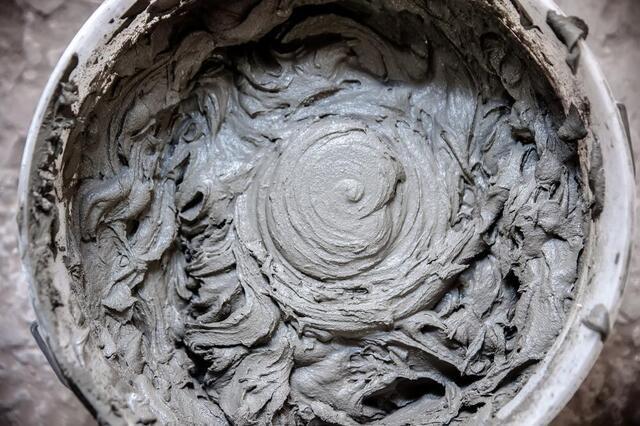
The mudjacking slurry is a mixture of water, soil, and cement.
Mudjacking, often called slabjacking or pressure grouting, is a method that has been used for several decades.
The mudjacking process involves injecting a mud-like mixture beneath the slab. The installer drills holes, typically about two inches in diameter, into your sunken concrete slab, and injects the mud-like mixture, often referred to as slurry.
The slurry is a special mixture of water, soil, and cement, hence the name “mudjacking”. This mud-like substance, when pumped under pressure, fills voids and gaps beneath the slab.
The pros and cons of mudjacking
At first glance, mudjacking seems like a great approach. After all, if the soil has compacted or washed away, it makes sense to put more soil – or a soil-like substance – under your slabs to replace it, right? It’s not a bad idea in theory, but it does have a few drawbacks.
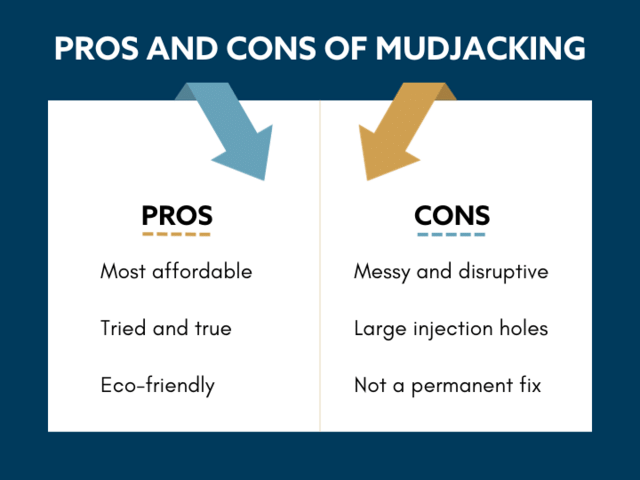
Pros of mudjacking:
1. It’s cost-effective. Mudjacking is not only more affordable than replacing your entire concrete slab, it’s typically less expensive when compared to polyjacking.
2. Eco-friendly. Mudjacking uses natural materials like soil and water to lift the concrete, which minimizes the environmental impact.
3. Tried and true. Mudjacking has been around for many, many years and has been the go-to concrete repair method for many contractors.
Cons of mudjacking:
1. It’s messy. The first drawback is right in the name: mud. And working with mud can get messy. The slurry mixture can spew out of the holes and cleanup isn’t always thorough, leaving a mess behind.

Mudjacking ports can't be matched perfectly, resulting in a strange polka-dot appearance on your concrete.
2. It shrinks. There’s a lot of water in the slurry mixture. It’s what allows the installers to pump it under the slabs. But, just like regular mud, it shrinks as it dries. This means that your slabs could sink again, sending you right back to square one.
3. Large injection holes. The second drawback is aesthetic, but no less important. The installer will drill a series of large ports in your slab. These need to be wide enough – at least 2” in diameter – so they don’t restrict the flow of the slurry. Unfortunately, these ports can’t be perfectly matched to your original concrete, resulting in a strange polka-dot appearance on your driveway or patio.
4. It doesn’t address the actual problem. Mudjacking addresses the symptoms of sunken concrete but fails to tackle the root cause: the unstable soil. If your concrete was sinking due to poorly compacted soil, then the heavy slurry mixture (we’re talking thousands of pounds) will exacerbate the problem by further compressing the soil, causing your concrete to sink even more.
What is polyjacking?
Polyjacking is a concrete lifting technique that involves injecting high-density, structural-grade polyurethane foam to lift, level, and stabilize your concrete slabs.

This image shows a 3D rendering of the poly foam filling gaps in the soil.
If mudjacking is the tried-and-true concrete repair method, then think of polyjacking as its cooler, younger sibling. It’s a newer method that uses the same concept as mudjacking, but improves upon it using better materials.
Polyjacking goes by many names – you’ll hear it called polyleveling, foam jacking, foam lifting, or polyurethane concrete lifting. But for this blog, we’ll refer to it as polyjacking.
The process involves injecting the polyurethane foam beneath the concrete slabs through small ports, roughly the size of a penny. The foam itself starts as a liquid, but quickly expands and hardens to support the concrete. In its liquid state, it flows like water, filling in every crack and crevice in the soil to provide the necessary support.
Once it hardens, it lifts the concrete above it and compresses the soil around it, all at the same time.
The pros and cons of polyjacking
Like any repair method, polyjacking has its advantages and disadvantages. Let’s explore some of the key pros and cons.

The pros of polyjacking:
1. Addresses the underlying issue. Unlike mudjacking, polyjacking not only raises concrete slabs, but also compacts the soil around it. This approach allows the slab to effectively float on the ultra-light, waterproof foam without exerting additional pressure on weak or unstable soils.
2. Long-term results. The poly foam used is durable and proven to last longer than the concrete itself.
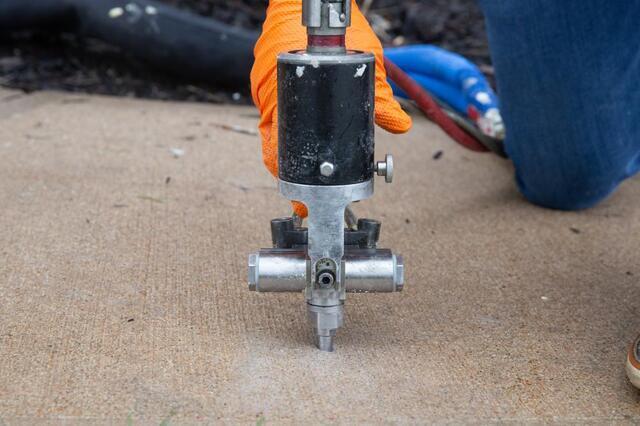
3. Fewer and smaller holes. Polyjacking requires fewer and smaller holes, approximately over an inch smaller than those needed for mudjacking.
4. Waterproof.The foam used is waterproof, meaning it won’t wash out from beneath the slab even when water builds up.
5. Little interruption. It installs and cures quickly, and in most cases, driveways can be used just 15 minutes after installation.
The cons of polyjacking:
Now, let’s look at a few drawbacks of polyjacking:
1. More expensive. Because of the specialized equipment, materials, and skilled labor, polyjacking tends to come with a higher price tag when compared to mudjacking.

2. Requires professionals. Polyjacking is a specialized process that should be performed by professionals with the right equipment and expertise – it’s not a weekend DIY project.
3. Doesn’t use natural materials. The foam used is derived from polyurethane, a synthetic substance. While it doesn’t affect the soil ecosystem, in comparison, polyjacking is less environmentally friendly than mudjacking.
Comparing the two: Mudjacking and Polyjacking
Now that we’ve gone through the pros and cons of each method, let’s discuss them side-by-side and consider important factors to help you decide.
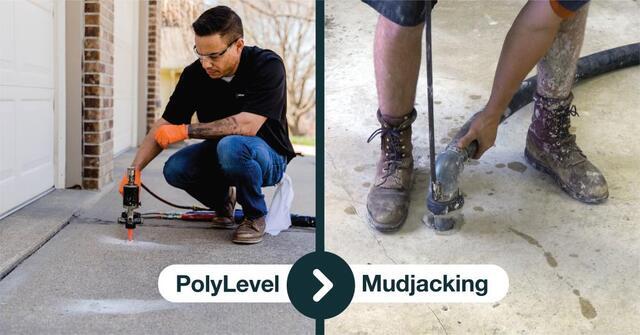
1. Cost considerations
Mudjacking: This technique often proves to be the most cost-effective option. Mudjacking materials, typically a mixture of mud and cement, are readily available and tend to be less expensive than the alternative methods.
Polyjacking: Polyjacking may be slightly more expensive than mudjacking. However, you should consider the long-term cost-effectiveness, as polyjacking can provide lasting results and doesn't require future repairs.
2. Long-term effectiveness
Mudjacking: While mudjacking can lift and level concrete surfaces, it may not provide long-lasting results. Over time, the mixture can break down and require additional maintenance.
Polyjacking: Polyjacking is known for its long-term effectiveness. The foam used is durable and can resist moisture, ensuring that the concrete remains in its lifted position for a long time.
3. Aesthetics and cleanliness
Mudjacking: Mudjacking may not be as aesthetically pleasing as polyjacking. The patched areas might not perfectly match the original concrete, and the process can be messier due to the mud-based materials used.
Polyjacking: Polyjacking often results in a cleaner and more visually appealing outcome. The polyurethane foam is less messy and the smaller injection holes are less visible.

4. Impact on soil stability
Mudjacking: Mudjacking doesn't necessarily address soil stability. It may raise the concrete surface, but it doesn't compact or stabilize the surrounding soil. This could potentially lead to the issue reoccurring.
Polyjacking: Polyjacking not only lifts the concrete but also addresses the underlying issue by compacting the soil around it. The lightweight foam increases the stability without increasing pressure on weak or unstable soils.
If you want to know our opinion…

This is our team in 2014, attending a seminar to learn about polyjacking.
When we write our blogs, it is always our goal to approach every topic objectively and stick to the facts, so you can make the best decision for your home and specific circumstances.
But as mentioned earlier in this blog, it’s worth noting that we have transitioned from offering mudjacking to exclusively providing polyjacking services. And we want to talk about why we made that switch.
At Thrasher, we’ve got a lot of experience with concrete lifting, spanning several decades. When we first started, mudjacking was the best choice for concrete repair. In 2012, we were introduced to polyjacking and it was a game-changer. With this new method, we instantly recognized how much better it was – in every aspect. That pivotal moment made it clear: we could no longer offer mudjacking, knowing that polyjacking was the best choice for homeowners.
So which method is the right choice for you?
While mudjacking is a cost-effective and traditional solution, polyjacking provides long-term results and a better look. But at the end of the day, it ultimately depends on your specific project, budget, and long-term expectations.
To make the best choice, weigh the pros and cons carefully, and consider your unique needs. The best advice we can give is to reach out to a reputable, concrete professional. These contractors can walk you through the process and answer all your questions regarding concrete repair.
If you're ready to explore the benefits of polyjacking for your concrete repair project, we're here to assist you. We offer free estimates, where we come to your home, inspect your concrete, explain the entire process, and give you an estimate for your specific project, all for free. If you want a thorough inspection, or even if you just have questions about concrete repair, call us at 1-402-389-4274, fill out this form, or start a chat in the bottom right-hand corner.
Article Categories:
